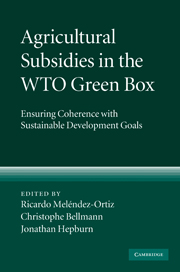Book contents
- Frontmatter
- Contents
- List of contributors
- Preface
- Acknowledgements
- List of abbreviations
- 1 Overview
- PART I The recent evolution of agricultural trade policy reform
- PART II The focus, extent and economic impact of green box subsidies
- 7 An analysis of EU, US and Japanese green box spending
- 8 Green box subsidies and trade-distorting support: is there a cumulative impact?
- 9 The distributional structure of green box subsidies in the European Union and France
- 10 The distributional structure of US green box subsidies
- PART III Green box subsidies and developing countries
- PART IV Green box subsidies and the environment
- PART V Looking forward: how can change take place?
- Appendix: Text of Annex 2 of the WTO Agreement on Agriculture (“the green box”)
- Index
- References
7 - An analysis of EU, US and Japanese green box spending
from PART II - The focus, extent and economic impact of green box subsidies
Published online by Cambridge University Press: 03 May 2010
- Frontmatter
- Contents
- List of contributors
- Preface
- Acknowledgements
- List of abbreviations
- 1 Overview
- PART I The recent evolution of agricultural trade policy reform
- PART II The focus, extent and economic impact of green box subsidies
- 7 An analysis of EU, US and Japanese green box spending
- 8 Green box subsidies and trade-distorting support: is there a cumulative impact?
- 9 The distributional structure of green box subsidies in the European Union and France
- 10 The distributional structure of US green box subsidies
- PART III Green box subsidies and developing countries
- PART IV Green box subsidies and the environment
- PART V Looking forward: how can change take place?
- Appendix: Text of Annex 2 of the WTO Agreement on Agriculture (“the green box”)
- Index
- References
Summary
Introduction
The URAA has provided a framework to discipline support for agricultural production. The domestic support pillar of the URAA has created a set of rules for individual members to classify and notify domestic support measures and an open mutual review process. The peace clause, which prevented members from using the Dispute Settlement Process to challenge agricultural measures that do not comply with WTO provisions, expired at the beginning of 2004.
The URAA framework is a legal structure derived from a complex negotiation process and oriented to discipline support through rules that need to be respected and applied. It is not meant to be an economic or analytical framework that takes into account all kinds of economic linkages, and it cannot be interpreted as a tool for the analysis of support. The notification process to the WTO has generated a database of support to agriculture in all member countries, which is classified according to specific criteria in various boxes and sub-boxes. This is particularly the case of the green box, which lists a series of payment types that are oriented to a briefly defined objective and have to conform to some general and specific provisions in Annex 2 of the URAA.
The purpose of this chapter is to look with some detail at the agricultural domestic support notifications to the WTO by the three main providers of support to agriculture: the EU, the US and Japan, which are called “the Trio” in this chapter.
- Type
- Chapter
- Information
- Agricultural Subsidies in the WTO Green BoxEnsuring Coherence with Sustainable Development Goals, pp. 137 - 238Publisher: Cambridge University PressPrint publication year: 2009



